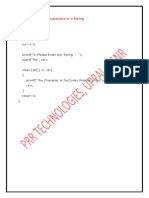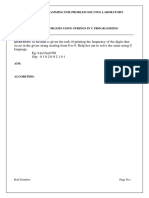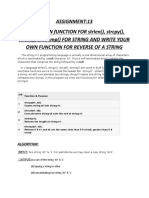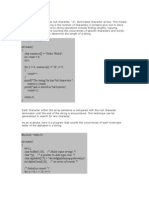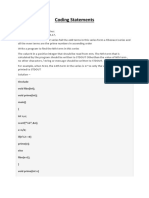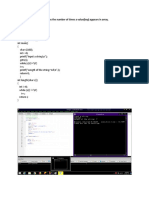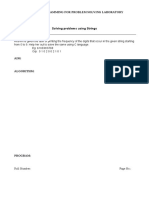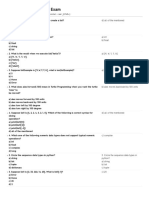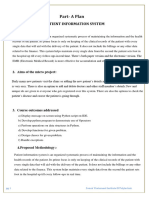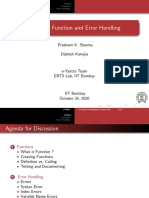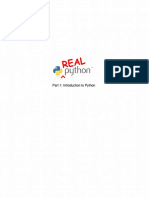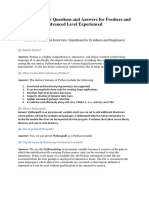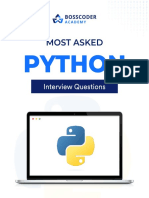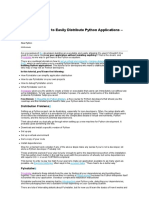HCL_Coding_Questions_1.
markdown 2025-08-13
HCL-Specific Coding Questions for BTech Campus
Recruitment
This document provides a curated list of coding questions commonly asked by HCL Technologies in BTech
campus recruitments, based on patterns observed in recent placement drives (2023–2025). These questions
test problem-solving skills, algorithmic thinking, and proficiency in programming languages like C, C++, Java,
or Python. Each question includes a problem description, input/output examples, approach, sample code, and
relevant metadata.
1. Move Hash to Front
Problem: Given a string containing some '#' characters, write a function to move all the '#' characters
to the front of the string and return the modified string.
Input: A string, e.g., "Move#Hash#to#Front"
Output: The string with all '#' moved to the front, e.g., "###MoveHashtoFront"
Approach:
Iterate through the string.
Collect '#' characters in one array and non-'#' characters in another.
Concatenate the '#' array with the non-'#' array to form the result.
Sample Code (C):
#include <stdio.h>
#include <string.h>
char* moveHash(char str[], int n) {
char str1[100], str2[100];
int j = 0, k = 0;
for (int i = 0; str[i]; i++) {
if (str[i] == '#') str1[j++] = str[i];
else str2[k++] = str[i];
}
str1[j] = '\0';
str2[k] = '\0';
strcat(str1, str2);
printf("%s", str1);
return str1;
}
int main() {
char a[100];
scanf("%[^\n]s", a);
moveHash(a, strlen(a));
return 0;
}
Topic: String Manipulation
1/8
�HCL_Coding_Questions_1.markdown 2025-08-13
2. Borrow Number
Problem: Given two numbers, number1 and number2, calculate the number of borrow operations
needed when subtracting number2 from number1. If subtraction is not possible (number1 < number2),
return "Not possible".
Input: Two integers, e.g., number1 = 754, number2 = 658
Output: Number of borrow operations, e.g., 2, or "Not possible"
Approach:
Compare digits of both numbers from right to left.
If a digit in number1 is less than the corresponding digit in number2 (or adjusted due to a
previous borrow), increment the borrow count and adjust the next digit.
If number1 < number2, return "Not possible".
Sample Code (C):
#include <stdio.h>
int main() {
int number1, number2, count = 0, flag = 0;
scanf("%d %d", &number1, &number2);
if (number1 < number2) {
printf("Not possible");
} else {
while (number1 != 0 && number2 != 0) {
int temp1 = number1 % 10;
int temp2 = number2 % 10;
if (flag == 1) temp1 -= 1;
if (temp1 < temp2) {
count++;
flag = 1;
} else {
flag = 0;
}
number1 /= 10;
number2 /= 10;
}
printf("%d", count);
}
return 0;
}
Topic: Number Theory
3. Capitalize/Decapitalize
Problem: Given a string and a character c, replace all occurrences of c in the string. If c is uppercase,
convert it to lowercase; if it is lowercase, convert it to uppercase.
2/8
�HCL_Coding_Questions_1.markdown 2025-08-13
Input: A string and a character, e.g., str = "hello world", c = 'l'
Output: Modified string, e.g., "heLLo worLd"
Approach:
Iterate through the string.
For each occurrence of the character c, check its case (ASCII range: 65–90 for uppercase, 97–122
for lowercase).
Toggle the case by adding or subtracting 32 to the ASCII value.
Sample Code (C):
#include <stdio.h>
#include <string.h>
void changeCharacter(char str[], char chr, int len) {
for (int i = 0; i < len; i++) {
if (chr == str[i]) {
if (str[i] >= 65 && str[i] <= 90) str[i] += 32;
else if (str[i] >= 97 && str[i] <= 122) str[i] -= 32;
}
}
printf("%s", str);
}
int main() {
char str[1000], chr;
scanf("%[^\n]s", str);
scanf(" %c", &chr);
changeCharacter(str, chr, strlen(str));
return 0;
}
Topic: String Manipulation
4. Reduce String with Repeated Characters
Problem: Given a string with consecutively repeated characters, reduce it by representing each
sequence of repeated characters as the character followed by its count (if count > 1).
Input: A string, e.g., "abbccccc"
Output: Reduced string, e.g., "ab2c5"
Approach:
Iterate through the string, counting consecutive occurrences of each character.
If a character appears once, output it as is; if more than once, output the character followed by
its count.
Sample Code (C):
3/8
�HCL_Coding_Questions_1.markdown 2025-08-13
#include <stdio.h>
int main() {
char str[100], str1[100];
scanf("%[^\n]s", str);
int k = 0, count;
for (int i = 0; str[i] != '\0'; i++) {
count = 0;
for (int j = 0; j <= i; j++) {
if (str[i] == str[j]) count++;
}
if (count == 1) str1[k++] = str[i];
}
str1[k] = '\0';
for (int i = 0; str1[i] != '\0'; i++) {
count = 0;
for (int j = 0; str[j] != '\0'; j++) {
if (str1[i] == str[j]) count++;
}
if (count == 1) printf("%c", str1[i]);
else printf("%c%d", str1[i], count);
}
return 0;
}
Topic: String Compression
5. Spiral Matrix
Problem: Given a 2D matrix, traverse it in a spiral order (clockwise from top-left).
Input: A 2D matrix, e.g., [[1,2,3,4], [5,6,7,8], [9,10,11,12], [13,14,15,16], [17,18,19,20]]
Output: Elements in spiral order, e.g., [1,2,3,4,8,12,16,20,19,18,17,13,9,5,6,7,11,15,14,10]
Approach:
Use four pointers (row_start, row_end, col_start, col_end) to track boundaries.
Traverse right, down, left, and up while updating boundaries and checking for overlap.
Sample Code (C):
#include <stdio.h>
int main() {
int a[5][4] = {{1,2,3,4},{5,6,7,8},{9,10,11,12},{13,14,15,16},
{17,18,19,20}};
int rs = 0, re = 5, cs = 0, ce = 4;
while (rs < re && cs < ce) {
for (int i = cs; i < ce; i++) printf("%d ", a[rs][i]);
rs++;
for (int i = rs; i < re; i++) printf("%d ", a[i][ce-1]);
ce--;
if (rs < re) {
for (int i = ce-1; i >= cs; i--) printf("%d ", a[re-1][i]);
re--;
4/8
�HCL_Coding_Questions_1.markdown 2025-08-13
}
if (cs < ce) {
for (int i = re-1; i >= rs; i--) printf("%d ", a[i][cs]);
cs++;
}
}
return 0;
}
Topic: Matrix Traversal
6. Sum of Digits in a String
Problem: Given a string containing a mix of alphabets, digits, and special characters, calculate the sum
of all digits.
Input: A string, e.g., "abc123def45"
Output: Sum of digits, e.g., 15
Approach:
Iterate through the string.
Check if each character is a digit using isdigit() or equivalent, and add its numeric value to the
sum.
Sample Code (Python):
def sum_of_digits(s):
total = 0
for ch in s:
if ch.isdigit():
total += int(ch)
return total
print(sum_of_digits("abc123def45")) # Output: 15
Topic: String Processing
7. Reverse Each Word in a Sentence
Problem: Reverse each word in a sentence while keeping the word order intact.
Input: A sentence, e.g., "hello world"
Output: Reversed words, e.g., "olleh dlrow"
Approach:
Split the sentence into words.
Reverse each word individually and join them back with spaces.
Sample Code (Python):
5/8
�HCL_Coding_Questions_1.markdown 2025-08-13
def reverse_words(sentence):
words = sentence.split()
result = [word[::-1] for word in words]
return ' '.join(result)
print(reverse_words("hello world")) # Output: olleh dlrow
Topic: String Manipulation
8. Count Vowels in a String
Problem: Count the number of vowels (a, e, i, o, u) in a string, ignoring case.
Input: A string, e.g., "Education"
Output: Number of vowels, e.g., 5
Approach:
Iterate through the string.
Check if each character is in a predefined set of vowels (case-insensitive).
Sample Code (Python):
def count_vowels(s):
vowels = 'aeiouAEIOU'
count = 0
for ch in s:
if ch in vowels:
count += 1
return count
print(count_vowels("Education")) # Output: 5
Companies: HCL
Difficulty: Easy
Topic: String Processing
9. Check Palindrome String
Problem: Determine if a given string is a palindrome (reads the same forward and backward), ignoring
case and assuming no spaces or symbols.
Input: A string, e.g., "madam"
Output: True if palindrome, else False
Approach:
Convert the string to lowercase.
Compare the string with its reverse.
Sample Code (Python):
6/8
�HCL_Coding_Questions_1.markdown 2025-08-13
def is_palindrome(s):
return s.lower() == s[::-1].lower()
print(is_palindrome("madam")) # Output: True
Topic: String Manipulation
10. Find Maximum Number in a List
Problem: Given a list of integers, find the largest number using a simple loop.
Input: A list of integers, e.g., [10, 20, 45, 6, 78]
Output: Maximum number, e.g., 78
Approach:
Initialize the maximum as the first element.
Iterate through the list, updating the maximum if a larger number is found.
Sample Code (Python):
def find_max(numbers):
max_val = numbers[0]
for num in numbers:
if num > max_val:
max_val = num
return max_val
print(find_max([10, 20, 45, 6, 78])) # Output: 78
Topic: Array Processing
HCL Coding Round Details
Format: Typically includes 2 coding questions to be solved in 20 minutes, alongside 30 computer
programming MCQs (30 minutes) covering topics like Data Structures, OOPS, OS, DBMS, and
Networking.
Difficulty: Easy to Medium, with occasional Hard questions like Spiral Matrix.
Languages Allowed: C, C++, Java, Python (choose one based on comfort).
Eligibility Criteria: B.Tech (CSE, IT, ECE, EN, EI, ME) with 75% throughout academics and no active
backlogs.
Key Topics:
String Manipulation: Reversing, palindrome checks, character counting, case conversion.
Arrays: Maximum/minimum elements, merging, or traversal.
Number Theory: Prime numbers, factorial, GCD, digit sums.
Matrix: Traversal (spiral, row-wise, column-wise).
7/8
�HCL_Coding_Questions_1.markdown 2025-08-13
Basic Data Structures: Linked lists, stacks, or queues may appear in MCQs or interviews.
Preparation Tips
1. Practice on Platforms: Use PrepInsta, GeeksforGeeks, or HackerRank to practice HCL-specific
questions. Focus on string and array problems, as they are frequent.
2. Time Management: With only 20 minutes for 2 coding questions, prioritize writing efficient code and
testing edge cases (e.g., empty strings, negative numbers).
3. Understand Basics: Be thorough with string operations, loops, conditionals, and basic data structures.
HCL emphasizes implementation over complex algorithms.
4. Mock Tests: Take HCL-specific mock tests on platforms like Sanfoundry or Unstop to simulate the
actual test environment.
5. Debugging Skills: Ensure your code handles edge cases (e.g., invalid inputs, large numbers) and passes
all test cases, as HCL’s coding platform evaluates based on test case accuracy.
Additional Notes
Interview Rounds: After the coding round, expect a technical interview focusing on coding, data
structures, and CS fundamentals (OS, DBMS, Networking), followed by an HR round.
Resources:
PrepInsta’s HCL Coding Questions Dashboard for practice problems.
GeeksforGeeks HCL SDE Sheet for a comprehensive problem list.
NextGenKodingHub for Python and Java solutions to HCL questions.
Company Context: HCL is a mass recruiter, and its coding questions are generally simpler than those
of product-based companies like Google or Amazon, focusing on practical implementation skills.
8/8














